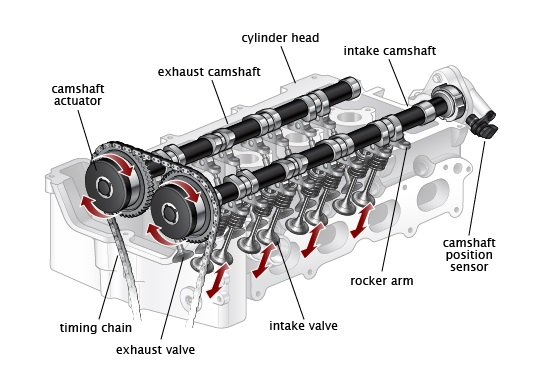Crankshafts:
The crankshaft is an engine component that converts the linear (reciprocating) motion of the piston into rotary motion. The crankshaft is the main rotating component of an engine and is commonly made of ductile iron.
All major components of the engine like piston,connecting rod etc. are supported by this shaft.
Construction Of Crankshaft:
A crankshaft is simply the same as an eccentric, except the eccentric is a much smaller diameter than the shaft itself Crankshaft length mainly depends on number of cylinders are present in engine .Firing order also considered while designing the Crankshaft .
Location :
Crankshaft is located in crank case . On Crankshaft, Connecting rods and pistons are mounted. The crankshaft rides on bearings which can wear down over time. The bearings support the crankshaft and also the rods which connect the pistons to the crankshaft.
Applications :
It actually part of an engine where the power is available , and this power is transferred in the form of torque to clutch and thereby gearbox and wheels.The main function is to convert liner motion of the piston to useful rotary motion.
Camshafts:
Camshaft is a part of engine which is responsible for opening and closing of exhaust and inlet valves.As the engines work they need to breathe out exhaust gases and take in fresh air ( charge) for the next cycle to take place . All these processes need to take place at a designated time with respect to each other. These processes are timed through opening and closing of valves and actuation of fuel pumps through a actuating mechanism which is triggered by movement of the crankshaft. The camshaft comes into picture here. The Crankshaft drives through a belt or chain drive the camshaft on which the inlet,exhaust, fuel pump cams are fitted for each unit when the crankshaft rotates it in turn rotates the camshaft which precisely actuate the valve and fuel pumps.
Construction Of Camshafts:
A camshaft is a long bar with egg-shaped eccentric lobes, one lobe for each valve and fuel injector.
The relationship between the rotation of the camshaft and the rotation of the crankshaft is of critical importance. Since the valves control the flow of the air/fuel mixture intake and exhaust gases, they must be opened and closed at the appropriate time during the stroke of the piston. For this reason, the camshaft is connected to the crankshaft either directly, via a gear mechanism, or indirectly via a belt or chain called a timing belt or timing chain.
Location :
Depending on the location of the camshaft, the cam operates the valves either directly or through a linkage of pushrods and rockers. Direct operation involves a simpler mechanism and leads to fewer failures, but requires the camshaft to be positioned at the top of the cylinders.
Applications :
This shaft receives the power from crankshaft (1:2) and operates the engine valves through cam and follower mechanism(generally mushroom headed follower is used to reduce friction b/w cam and follower).


